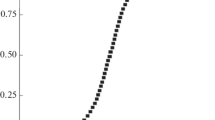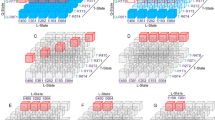Abstract
A mechanism for indirect allosteric action of charged effectors on substrate binding to a macromolecule is proposed. It is accounted for by electrostatic interaction among effectors in the solution, away from their receptors. The possibility of the mechanism proposed is tested in the allosteric action of univalent salt and 2,3-diphosphoglycerate on oxygen binding to hemoglobin. A model for electrostatic interaction between these two effectors in the solution and for their overall effect on oxygen binding is introduced. The 2,3-diphosphoglycerate binding constant to deoxygenated hemoglobin as a function of univalent salt concentration and the median ligand activity as a function of the concentration of univalent salt and 2,3-diphoshoglycerate are calculated and compared with experimental data. The obtained results indicate that electrostatic interaction in the solution may significantly contribute to indirect allosteric action of charged effectors.
Similar content being viewed by others
References
Antonini, E., Amiconi, G., Brunori, M.: The effect of anions and cations on the oxygen equilibrium of human hemoglobin. In: Oxygen affinity of hemoglobin and red cell acid base status (eds. M. RØth, P. Astrup). Copenhagen/New York: Munksgaard/Academic Press 1972
Arnone, A.: X-ray diffraction study of binding of 2,3-diphosphoglycerate to human deoxyhaemoglobin. Nature (Lond.)237, 146–149 (1972)
Baldwin, J. M.: Structure and function of haemoglobin. Progr. Biophys. molec. Biol.29, 225–320 (1975)
Benesch, R., Benesch, R. E.: The effect of organic phosphates from human erythrocyte on the allosteric properties of hemoglobin. Biochem. biophys. Res. Commun.26, 162–167 (1967)
Benesch, R. E., Benesch, R., Renthal, R.: Cofactor binding and oxygen equilibria in haemoglobin. Nature (Lond.)234, 174–176 (1971)
Benesch, R. E., Benesch, R., Yu, C. I.: The oxygenation of hemoglobin in the presence of 2,3-diphosphoglycerate. Effect of temperature, pH, ionic strength, and hemoglobin concentration. Biochemistry (Easton)8, 2567–2571 (1969)
Chanutin, A., Curnish, R. R.: Effect of organic and inorganic phosphates on the oxygen equilibrium of human erythrocytes. Arch. Biochem. Biophys.121, 96–102 (1967)
Chanutin, A., Herman, E.: The interaction of organic and inorganic phosphates with hemoglobin. Arch. Biochem. Biophys.131, 180–184 (1969)
Chiancone, E., Norne, J. E., Forsén, S., Antonini, E., Wyman, J.: Nuclear magnetic resonance quadrupole relaxation studies of chloride binding to human oxy- and deoxyhemoglobin. J. molec. Biol.70, 675–688 (1972)
Chiancone, E., Norne, J. E., Forsén, S., Bonaventura, J., Brunori, M., Antonini, E., Wyman, J.: Identification of chloride-binding sites in hemoglobin by nuclear-magnetic-resonance quadrupole-relaxation studies of hemoglobin digests. Europ. J. Biochem.55, 385–390 (1975)
Deal, W. J.: Cooperative binding of oxygen to hemoglobin: Analysis of accurate equilibrium binding data. Biopolymers12, 2057–2073 (1973)
Garby, L., Gerber, G., de Verdier, C.-H.: Binding of 2,3-diphosphoglycerate and adenosine triphosphate to human hemoglobin A. Europ. J. Biochem.10, 110–115 (1969)
Hedlund, B. E., Lovrien, R.: Thermodynamics of 2,3-diphosphoglycerate association with human oxy- and deoxyhemoglobin. Biochem. biophys. Res. Commun.61, 859–867 (1974)
Herzfeld, J., Stanley, H. E.: A general approach to co-operativity and its application to the oxygen equilibrium of hemoglobin and its effectors. J. molec. Biol.82, 231–265 (1974)
Kilmartin, J. V., Rossi-Bernardi, L.: Interaction of hemoglobin with hydrogen ions, carbon dioxide, and organic phosphates. Physiol. Rev.53, 836–890 (1973)
Maeda, T., Imai, K., Tyuma, I.: Effects of 2,3-diphosphoglycerate on the oxygen equilibria of the half-cyanmet hybrid hemoglobins. Biochemistry (Easton)11, 3685–3689 (1972)
Perutz, M. F.: Stereochemistry of cooperative effects in haemoglobin. Nature (Lond.)228, 726–739 (1970)
Perutz, M. F., Muirhead, H., Cox, J. M., Goaman, L. C. G.: Three-dimensional Furier synthesis of horse oxyhaemoglobin at 2.8 å resolution: The atomic model. Nature (Lond.)219, 131–139 (1968)
Ruckpaul, K., Rein, H., Ristau, O., Jänig, G.-R., Jung, F.: Interaction of hemoglobin with ions. Allosteric effects of the binding of anions. Biochem. biophys. Acta (Amst.)236, 211–221 (1971)
Szabo, A., Karplus, M.: Analysis of the interaction of organic phosphates with hemoglobin. Biochemistry (Easton)15, 2869–2877 (1976)
Tyuma, I., Imai, K., Shimizu, K.: Analysis of oxygen equilibrium of hemoglobin and control mechanism of organic phosphates. Biochemistry (Easton)12, 1491–1498 (1973)
Wyman, J.: Linked functions and reciprocal effects in hemoglobin: A second look. Advanc. Protein Chem.19, 223–286 (1964)
Author information
Authors and Affiliations
Rights and permissions
About this article
Cite this article
Brumen, M., Svetina, S. A mechanism for indirect allosteric action of charged effectors. Biophys. Struct. Mechanism 4, 201–207 (1978). https://doi.org/10.1007/BF02426085
Received:
Accepted:
Issue Date:
DOI: https://doi.org/10.1007/BF02426085




